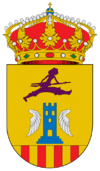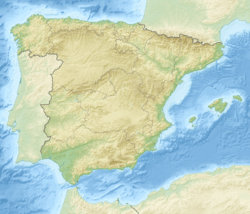Alacón facts for kids
Quick facts for kids
Alacón, Spain
|
|||
|---|---|---|---|
|
|||
| Country | Spain | ||
| Autonomous community | Aragon | ||
| Province | Teruel | ||
| Municipality | Alacón | ||
| Area | |||
| • Total | 47 km2 (18 sq mi) | ||
| Population
(2018)
|
|||
| • Total | 264 | ||
| • Density | 5.62/km2 (14.55/sq mi) | ||
| Time zone | UTC+1 (CET) | ||
| • Summer (DST) | UTC+2 (CEST) | ||
Alacón is a small town in Spain. It is located in the province of Teruel, which is part of the Aragon region. In 2018, about 264 people lived there. The town is located high up, at 704 meters (about 2,300 feet) above sea level.
Alacón is known for its interesting history and old buildings. It also has a special museum where you can learn about ancient times.
Contents
Historic Buildings in Alacón
Alacón has some really old and cool buildings. They tell stories about the town's past.
The Ancient Moorish Tower
The town has a military tower called "Torre de los Moros," which means "Tower of the Moors." The Moors were people from North Africa who lived in Spain a long time ago. They built this tower. It has a square shape with a pyramid-like top. This tower is very old, dating back to the time of the Reconquista. The Reconquista was when Christian kingdoms took back control of Spain from the Moors. This tower is one of the oldest in the whole province!
Churches and Chapels
Alacón also has beautiful religious buildings.
The Parish Church
The main church in Alacón is called the Parish Church. It was built in the 1700s. This church is dedicated to the Assumption. It has three main sections inside and a round dome. The dome has cool carvings on it.
Old Hermitages
You can also find two old chapels, called hermitages, on a hill.
- One hermitage is dedicated to El Calvario (Calvary). It was built in the 1500s and shows a mix of Gothic and Renaissance styles.
- The other hermitage is dedicated to San Miguel (St. Michael). It was built in the 1600s and has been restored.
Local Products
The town of Alacón is also known for growing olives. These olives are used to make a special olive oil. This oil has a special guarantee that it is high quality and comes from this area.
Paleontological Discovery Centre
The Paleontological Discovery Centre is a museum in Alacón. It's a great place to learn about really old history!
What is Paleontology?
Paleontology is the study of fossils. Fossils are the remains or traces of ancient life, like bones or tools, preserved in rock.
Discoveries at Covacho de Eudoviges
The museum focuses on the Mousterian culture. This was a type of human culture from the middle Paleolithic period. This period was between 50,000 and 35,000 years ago.
Scientists found an important archaeological site nearby called Covacho de Eudoviges. It is located at the top of a deep valley that leads to the Martín river.
What Was Found?
When scientists dug here in 1969-1970, they found many interesting things:
- About 670 tools made from flint stone.
- 50 cores of ferrite (a type of iron).
- Nearly 10,000 stone chips and other pieces. These were leftover materials from when ancient people made their tools.
- Musterian spearheads, which were tips for spears.
Unfortunately, the soil in this area destroyed most of the ancient animal bones and human fossils. These would have been left behind by the prehistoric people who lived and ate there.
Ancient Animal Bones
Even though many bones were destroyed, scientists did find some important animal remains:
- A rhinoceros from that ancient time.
- A prehistoric horse.
- An animal from the deer family, probably a buck. These animals lived during the middle to late Pleistocene period.
Scientists also found pottery from nomads. These were people who moved around a lot. This pottery dated back to the late Neolithic or early Bronze Age.
See also
 In Spanish: Alacón para niños
In Spanish: Alacón para niños




